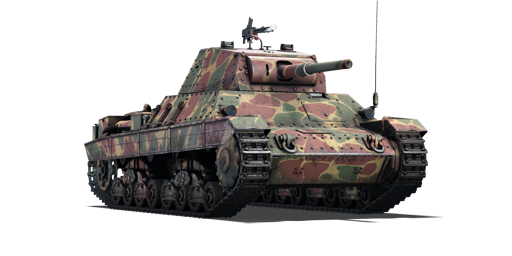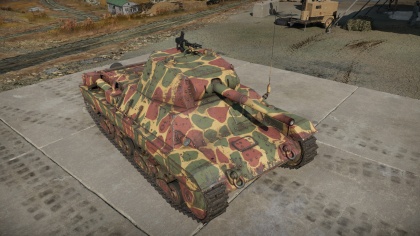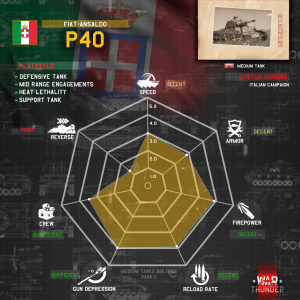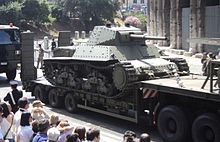Difference between revisions of "P40"
(German usage after Italian Armistice and vehicles sill existing.) (Tag: Visual edit) |
(Added a paragraph to a photo) (Tag: Visual edit) |
||
| Line 211: | Line 211: | ||
== History == | == History == | ||
| − | <!-- ''Describe the history of the creation and combat usage of the vehicle in more detail than in the introduction. If the historical reference turns out to be too long, take it to a separate article, taking a link to the article about the vehicle and adding a block "/History" (example: <nowiki>https://wiki.warthunder.com/(Vehicle-name)/History</nowiki>) and add a link to it here using the <code>main</code> template. Be sure to reference text and sources by using <code><nowiki><ref></ref></nowiki></code>, as well as adding them at the end of the article with <code><nowiki><references /></nowiki></code>. This section may also include the vehicle's dev blog entry (if applicable) and the in-game encyclopedia description (under <code><nowiki>=== In-game description ===</nowiki></code>, also if applicable).'' -->[[File:P40 at Army parade.jpg|thumb]] | + | <!-- ''Describe the history of the creation and combat usage of the vehicle in more detail than in the introduction. If the historical reference turns out to be too long, take it to a separate article, taking a link to the article about the vehicle and adding a block "/History" (example: <nowiki>https://wiki.warthunder.com/(Vehicle-name)/History</nowiki>) and add a link to it here using the <code>main</code> template. Be sure to reference text and sources by using <code><nowiki><ref></ref></nowiki></code>, as well as adding them at the end of the article with <code><nowiki><references /></nowiki></code>. This section may also include the vehicle's dev blog entry (if applicable) and the in-game encyclopedia description (under <code><nowiki>=== In-game description ===</nowiki></code>, also if applicable).'' -->[[File:P40 at Army parade.jpg|thumb|P26/40 at Italian Army parade i 2011]] |
The Carro Pesante P26/40 was Italy's best tank that saw service in the war. Despite only weighing 29 tonnes, which is significantly less than almost every other country's heavy tanks, it was classed as a heavy tank due to Italy's tank design doctrine. In early 1940, the Italians started working on a 25 tonne "heavy" infantry support tank that was intended to fight alongside the "M" class medium tanks. The recent Africa campaign showed the massive problems the Italian tanks in production had, namely a lack of armour and insufficient firepower, prompting the army to make some changes. Initially designated as "P75" due to the 75 mm short-barrelled 75/32 mm cannon that was changed to a longer barrelled 75/34 with higher potency. The initial prototype was powered by a 330 hp diesel engine but was changed to a traditional petrol-fueled engine due to the unimpressive performance of the diesel engine, which forced the Ansaldo engineers to delay the program until the necessary modifications to the chassis and body could be made to fit the petrol engine. This eventually produced a petrol engine titled "V-12 SPA 342" delivering 420 hp. The vehicle was adopted and was named "P26/40", 26 for the weight and 40 for the year it was designed. Before the Italian Armistice of the 8 September 1943, the Carro Pesante P26/40's were produced in a very little number (between 1 and 5 pre-production vehicles) and they were taken by the Wehrmacht. Then the Germans produced a slightly bigger number of models without using the engine designed by the Italians, instead they used a German one; they also produced some of them without engine for a combat usage as static strongpoints. Today two Carro Pesante P26/40 still exists: one of them is in the ''Museo della Motorizzazione'' in Rome, while the other one is in display near Italian Army barracks in Lecce. | The Carro Pesante P26/40 was Italy's best tank that saw service in the war. Despite only weighing 29 tonnes, which is significantly less than almost every other country's heavy tanks, it was classed as a heavy tank due to Italy's tank design doctrine. In early 1940, the Italians started working on a 25 tonne "heavy" infantry support tank that was intended to fight alongside the "M" class medium tanks. The recent Africa campaign showed the massive problems the Italian tanks in production had, namely a lack of armour and insufficient firepower, prompting the army to make some changes. Initially designated as "P75" due to the 75 mm short-barrelled 75/32 mm cannon that was changed to a longer barrelled 75/34 with higher potency. The initial prototype was powered by a 330 hp diesel engine but was changed to a traditional petrol-fueled engine due to the unimpressive performance of the diesel engine, which forced the Ansaldo engineers to delay the program until the necessary modifications to the chassis and body could be made to fit the petrol engine. This eventually produced a petrol engine titled "V-12 SPA 342" delivering 420 hp. The vehicle was adopted and was named "P26/40", 26 for the weight and 40 for the year it was designed. Before the Italian Armistice of the 8 September 1943, the Carro Pesante P26/40's were produced in a very little number (between 1 and 5 pre-production vehicles) and they were taken by the Wehrmacht. Then the Germans produced a slightly bigger number of models without using the engine designed by the Italians, instead they used a German one; they also produced some of them without engine for a combat usage as static strongpoints. Today two Carro Pesante P26/40 still exists: one of them is in the ''Museo della Motorizzazione'' in Rome, while the other one is in display near Italian Army barracks in Lecce. | ||
Revision as of 09:58, 7 November 2020
Contents
| This page is about the Italian medium tank P40. For other uses, see P40 (Disambiguation). For the premium version, see P40 "G.C. Leoncello". |
Description
The Fiat-Ansaldo P40 is a rank II Italian medium tank
with a battle rating of 3.3 (AB/RB/SB). It was introduced in Update 1.85 "Supersonic".
General info
Survivability and armour
Armour type:
- Rolled homogeneous armour
- Structural steel
| Armour | Front (Slope angle) | Sides | Rear | Roof |
|---|---|---|---|---|
| Hull | 50 mm (45°), 30 mm (78°), 45 mm (45°) Front glacis 50 mm (38°) Lower glacis 74 mm (45°) Driver's hatch |
45 mm (35°) Top 40 mm Bottom |
40 mm Fighting compartment rear 40 mm (10-40°) |
45 mm Front 15 mm Rear |
| Turret | 50 mm (20°) Turret front 48 + 48 mm (1-78°) Gun mantlet |
45 mm (25-26°) | 45 mm Top 23 + 50 + 45 mm Turret bustle |
20 mm |
Notes:
- Suspension wheels are 15 mm thick, bogies are 10 mm thick, and tracks are 20 mm thick.
- 4 mm side skirts line up parts of the bottom side hull.
- Belly armour is 14 mm thick.
Its protection is enough for most medium-ranged engagements but is able to be easily penetrated by most guns at close range. The front plate is a 50 mm plate sloped at 45° allowing for 65-67 mm of total protection, and the drivers hatch on the left side is 76 mm also sloped at 45° allowing for nearly 100 mm of protection. Most shots to the upper glacis won't penetrate thanks to the radical sloping angle of the plate offering 95 mm of armour, but it is possible for it to deflect a shot into the UFP. The gun mantlet is very well protected, with two rounded plates, which each offer roughly 50 mm of protection, stacked on top of each other allowing for a total of 100 mm. Be wary that the turret is a very vulnerable spot due to the nearly flat plate that only has 50 mm of armour.
Mobility
| Game Mode | Max Speed (km/h) | Weight (tons) | Engine power (horsepower) | Power-to-weight ratio (hp/ton) | |||
|---|---|---|---|---|---|---|---|
| Forward | Reverse | Stock | Upgraded | Stock | Upgraded | ||
| Arcade | 45 | 5 | 26 | 511 | 630 | 19.65 | 24.23 |
| Realistic | 41 | 5 | 292 | 330 | 11.23 | 12.69 | |
Mobility is below average for the rank but is faster than some common tanks like the early Sherman's and Chi-Nu. However, almost every other tank in the rank will easily outrun the P40 (Such as the early T-34's, Cromwell's, Pz.III and the Pz.IV F2). The tank's offroad speed is quite good, able to reach 43 kmh / 27 mph on dirt and get to that speed quite quickly. The hull traverse is also very good and the tank is very responsive while in motion, allowing for a very mobile playstyle.
Armaments
Main armament
The P40 is armed with a Ansaldo 75 L/34, able to carry a total of 63 shells. combining a decent reload with flexible munitions. The P40 has access to a 75 mm APHE round with 79 mm of penetration and a HEAT round with 100 mm of penetration. It is worth noting, either ammunition is usable, but a mix is preferable. Most enemies will easily fall prey to the APHE round, but T-34s, M4 Shermans, and KV-1s, are all enemies that require heavier hitting rounds, like the HEAT round. Note turret rotation is mediocre, and traversing the hull is necessary during close range engagements. The average round velocity will make longer-range combat difficult and the penetration drop off of the APHE round becomes quite noticeable.
| 75 mm Ansaldo 75 L/34 | Turret rotation speed (°/s) | Reloading rate (seconds) | |||||||||||
|---|---|---|---|---|---|---|---|---|---|---|---|---|---|
| Mode | Capacity | Vertical | Horizontal | Stabilizer | Stock | Upgraded | Full | Expert | Aced | Stock | Full | Expert | Aced |
| Arcade | 63 | -10°/+23° | ±180° | N/A | 8.3 | 11.5 | 22.4 | 24.8 | 56.4 | 6.5 | 5.8 | 5.3 | 5.0 |
| Realistic | 8.3 | 9.8 | 11.9 | 13.2 | 14.0 | ||||||||
Ammunition
| Penetration statistics | |||||||
|---|---|---|---|---|---|---|---|
| Ammunition | Type of warhead |
Penetration @ 0° Angle of Attack (mm) | |||||
| 10 m | 100 m | 500 m | 1,000 m | 1,500 m | 2,000 m | ||
| Granata Perforante 75/32 | APCBC | 75 | 72 | 66 | 59 | 53 | 48 |
| EPS M42 | HEAT | 100 | 100 | 100 | 100 | 100 | 100 |
| Granata 75/32 | HE | 9 | 9 | 9 | 9 | 9 | 9 |
| Shell details | |||||||||
|---|---|---|---|---|---|---|---|---|---|
| Ammunition | Type of warhead |
Velocity (m/s) |
Projectile Mass (kg) |
Fuse delay (m) |
Fuse sensitivity (mm) |
Explosive Mass (TNT equivalent) (g) |
Ricochet | ||
| 0% | 50% | 100% | |||||||
| Granata Perforante 75/32 | APCBC | 637 | 6.35 | 1.2 | 14.0 | 270 | 48° | 63° | 71° |
| EPS M42 | HEAT | 552 | 5.30 | N/A | 0.1 | 656.6 | 62° | 69° | 73° |
| Granata 75/32 | HE | 552 | 6.35 | 0.4 | 0.1 | 600 | 79° | 80° | 81° |
Ammo racks
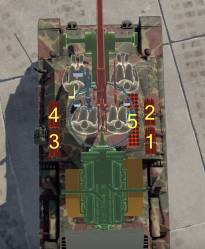
| Full ammo |
1st rack empty |
2nd rack empty |
3rd rack empty |
4th rack empty |
5th rack empty |
6th rack empty |
Visual discrepancy |
|---|---|---|---|---|---|---|---|
| 63 | 58 (+5) | 53 (+10) | 48 (+15) | 43 (+20) | 22 (+41) | 1 (+62) | No |
Sponsons empty: 43 (+20)
Machine guns
| 8 mm Breda Mod. 38 | ||||
|---|---|---|---|---|
| Mount | Capacity (Belt) | Fire rate | Vertical | Horizontal |
| Pintle | 288 (24) | 600 | -10°/+20° | ±180° |
| Coaxial | 288 (24) | 600 | N/A | N/A |
Usage in battles
The P40 is a tank that excels in medium-ranged engagements thanks to its decent armour and adequate gun. Due to the relatively small size and good mobility, it can, however, be played as an ambush tank that can sneak around and plant a shot in the enemy's sides, allowing for an easy elimination because of the large explosive filler in the APCBC shell. Be wary that while the tank's armour may protect against many lower-rank cannons, cannons at equivalent BR (Namely the Pz.IV's long-barrelled cannon) are easily capable of destroying the tank.
Players in the P40 should always be with teammates, as the P40 is easy prey when separated from its team. Stick with the heavier tanks such as the KV-1's, Churchill's and Matilda's, as they can soak up shots and draw attention away from the weak little P40, allowing the player to sneak around and hit a few tanks. If there are no heavy tanks, the P40's best bet is to support a Sherman or Pz.IV, as both of them can deal with enemies that the P40 can't.
Modules
| Tier | Mobility | Protection | Firepower | ||
|---|---|---|---|---|---|
| I | Tracks | Parts | Horizontal Drive | EPS M42 | |
| II | Suspension | Brake System | FPE | Adjustment of Fire | |
| III | Filters | Crew Replenishment | Elevation Mechanism | Smoke grenade | |
| IV | Transmission | Engine | Artillery Support | ||
Pros and cons
Pros:
- Decent frontal armour
- The gun possesses satisfactory performance at its rank
- Has access to HEAT shells with 100 mm of penetration
- Stock shell has a lot of explosive filler, making one-shot very common
- Relatively small for a medium tank
- Very good in medium-ranged performance
- Relatively consistent armour protection all around the tank ~ good for angling
Cons:
- Overall penetration is not that great
- Pitifully low ammo count for each machine gun belt
- Armour can still be penetrated by a few enemies of rank II, most notably by the long-barreled Panzer IVs
- Breda Mod. 38's have a very low magazine count
- Lower than the average speed
- Mediocre turret traverse
History
The Carro Pesante P26/40 was Italy's best tank that saw service in the war. Despite only weighing 29 tonnes, which is significantly less than almost every other country's heavy tanks, it was classed as a heavy tank due to Italy's tank design doctrine. In early 1940, the Italians started working on a 25 tonne "heavy" infantry support tank that was intended to fight alongside the "M" class medium tanks. The recent Africa campaign showed the massive problems the Italian tanks in production had, namely a lack of armour and insufficient firepower, prompting the army to make some changes. Initially designated as "P75" due to the 75 mm short-barrelled 75/32 mm cannon that was changed to a longer barrelled 75/34 with higher potency. The initial prototype was powered by a 330 hp diesel engine but was changed to a traditional petrol-fueled engine due to the unimpressive performance of the diesel engine, which forced the Ansaldo engineers to delay the program until the necessary modifications to the chassis and body could be made to fit the petrol engine. This eventually produced a petrol engine titled "V-12 SPA 342" delivering 420 hp. The vehicle was adopted and was named "P26/40", 26 for the weight and 40 for the year it was designed. Before the Italian Armistice of the 8 September 1943, the Carro Pesante P26/40's were produced in a very little number (between 1 and 5 pre-production vehicles) and they were taken by the Wehrmacht. Then the Germans produced a slightly bigger number of models without using the engine designed by the Italians, instead they used a German one; they also produced some of them without engine for a combat usage as static strongpoints. Today two Carro Pesante P26/40 still exists: one of them is in the Museo della Motorizzazione in Rome, while the other one is in display near Italian Army barracks in Lecce.
Media
Excellent additions to the article would be video guides, screenshots from the game, and photos.
See also
Links to the articles on the War Thunder Wiki that you think will be useful for the reader, for example:
- reference to the series of the vehicles;
- links to approximate analogues of other nations and research trees.
External links
Paste links to sources and external resources, such as:
- topic on the official game forum;
- encyclopedia page on the tank;
- other literature.
| Italy medium tanks | |
|---|---|
| Italy | |
| M13/40 | M13/40 (I) · M13/40 (II) · M13/40 (III) |
| M14/41 | M14/41 · M14/41 (47/40) |
| M15/42 | M15/42 |
| M16/43 | Celere Sahariano |
| P26/40 | P40 · P40 "G.C. Leoncello" |
| OF-40 | OF-40 · OF-40 Mk.2A · OF-40 (MTCA) |
| Ariete | Ariete (P) · Ariete · Ariete PSO · Ariete AMV |
| Germany | ▄Pz.III N · ▄Pz.IV G · ▄Leopard 1A5 |
| Allied powers | ▄Sherman I Composito · Sherman Ic · ▄Sherman Vc · ▄Sherman V · M26 "D.C.Ariete" · M26A1 · M47 (105/55) · M60A1 "D.C.Ariete" |
| Hungary | |
| Turán | Turan I · Turan II · Turan III |
| Germany | ◔Leopard 2A4 · Leopard 2A7HU |
| USSR | ◔T-72M1 |


